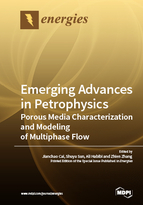Emerging Advances in Petrophysics: Porous Media Characterization and Modeling of Multiphase Flow
A special issue of Energies (ISSN 1996-1073).
Deadline for manuscript submissions: closed (30 September 2018) | Viewed by 58601
Special Issue Editors
Interests: porous media; nanofluids; EOR; fractal; capillary pressure; imbibition; mutlphase flow in porous media
Special Issues, Collections and Topics in MDPI journals
Interests: numerical oil reservoir simulations and computational transport phenomena; computational thermodynamics of reservoir fluid; finite element methods
Special Issues, Collections and Topics in MDPI journals
Interests: wettability evaluation of unconventional resources; rock-fluids interactions; EOR techniques in tight oil formations; surfactant EOR; formation damage reduction; scaling
Special Issues, Collections and Topics in MDPI journals
Interests: gas separation; CO2 capture; polymeric membrane; membrane separation; membrane contactor; membrane absorption; modeling; membrane preparation; membrane characterization
Special Issues, Collections and Topics in MDPI journals
Special Issue Information
Dear Colleagues,
Petrophysics, especially studies on porous media characterization and multiphase flow, are relevant to multi-disciplinary porous media research, such as hydrocarbon extraction, geosciences, environmental issues, hydrology, biology, and so on. The relevant stakeholders in this issue are the petroleum industry, subsurface water, air and water pollution authorities and service companies, environmental authorities, and bio-material society. Reliable characterization of porous media and multiphase flow functions is crucial to many simulation applications, including studies of residual water or oil in hydrocarbon reservoirs and long-term storage of supercritical CO2 in geological formations.
We invite investigators to submit original research articles, case studies, as well as review articles, to address the challenges that are related to porous media characterization and multiphase flow, which will stimulate continuous efforts on new and modern methods and techniques for petrophysics.
Prof. Dr. Jianchao Cai
Assoc. Prof. Shuyu Sun
Assoc. Prof. Hassan Dehghanpour
Dr. Zhien Zhang
Guest Editors
Manuscript Submission Information
Manuscripts should be submitted online at www.mdpi.com by registering and logging in to this website. Once you are registered, click here to go to the submission form. Manuscripts can be submitted until the deadline. All submissions that pass pre-check are peer-reviewed. Accepted papers will be published continuously in the journal (as soon as accepted) and will be listed together on the special issue website. Research articles, review articles as well as short communications are invited. For planned papers, a title and short abstract (about 100 words) can be sent to the Editorial Office for announcement on this website.
Submitted manuscripts should not have been published previously, nor be under consideration for publication elsewhere (except conference proceedings papers). All manuscripts are thoroughly refereed through a single-blind peer-review process. A guide for authors and other relevant information for submission of manuscripts is available on the Instructions for Authors page. Energies is an international peer-reviewed open access semimonthly journal published by MDPI.
Please visit the Instructions for Authors page before submitting a manuscript. The Article Processing Charge (APC) for publication in this open access journal is 2600 CHF (Swiss Francs). Submitted papers should be well formatted and use good English. Authors may use MDPI's English editing service prior to publication or during author revisions.
Keywords
- rock characterization and reconstruction
- hydrofracturing methods
- tight porous media analysis
- pore network modeling
- upscaling of single-phase and multiphase flows
- fractal modeling
- multiscale modeling of porous media flow
- oil and gas flow in unconventional formations
- coupled transport phenomena
- gas capture and storage
- capillary pressure-saturation curve
- wettability of geological media and its variation









